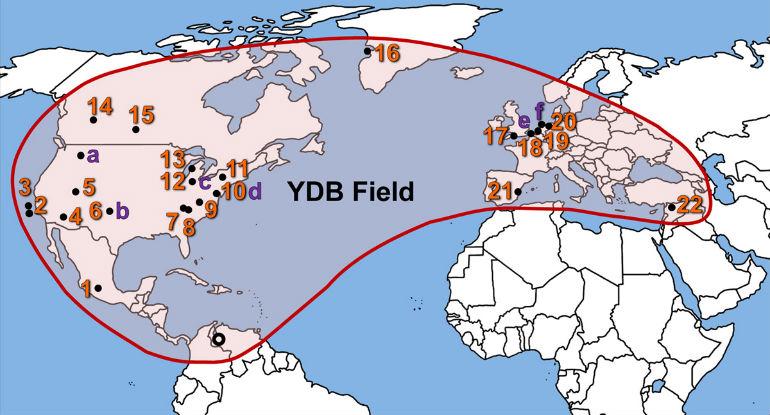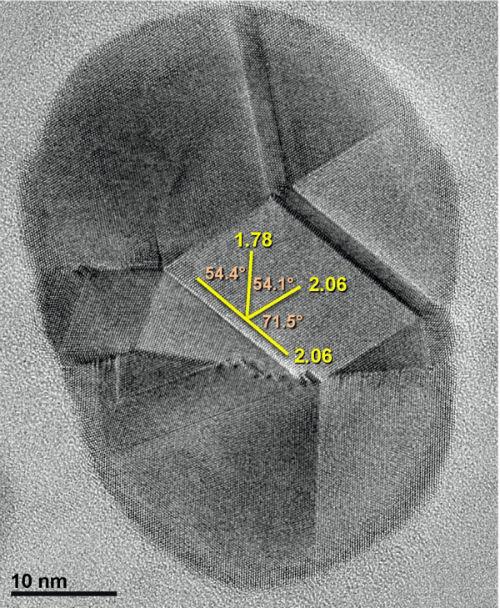Tiny diamonds invisible to the human eye—but confirmed by microscope—add weight to a theory first proposed in 2007 that a comet that exploded over North America sparked catastrophic climate change 12,800 years ago.
A new paper published the Journal of Geology reports the definitive presence of nanodiamonds at some 32 sites in 11 countries on three continents in layers of darkened soil at the Earth’s Younger Dryas boundary.
The boundary layer is widespread. The nanodiamonds, which often form during large impact events, are abundant along with cosmic impact spherules, high-temperature melt-glass, fullerenes, grape-like clusters of soot, charcoal, carbon spherules, glasslike carbon, heium-3, iridium, osmium, platinum, nickel, and cobalt.
The combination of components is similar to that found in soils connected with the 1908 in-air explosion of a comet over Siberia and those found in the Cretaceous-Tertiary Boundary (KTB) layer that formed 65 million years ago when a comet or asteroid struck off Mexico and wiped out dinosaurs worldwide.

A map of the area in the Younger Dryas boundary field covered by the research. (University of Oregon)
Comet Airbursts
In the Oct. 9, 2007, issue of the Proceedings of the National Academy of Sciences, researchers proposed that a cosmic impact event, possibly multiple airbursts of comets, set off a 1,300-year-long cold spell known as the Younger Dryas, fragmented the prehistoric Clovis culture, and led to widespread extinctions across North America.
Douglas Kennett, a coauthor of the new paper and now at Penn State, was a member of the original study.
In that paper and in a series of subsequent studies, reports of nanodiamond-rich soils were documented at numerous sites. However, numerous critics refuted the findings, holding to a long-running theory that over-hunting sparked the extinctions and that the suspected nanodiamonds had been formed by wildfires, volcanism, or occasional meteoritic debris, rather than a cosmic event.
The glassy and metallic materials in the YDB layers would have formed at temperatures in excess of 2,200 degrees Celsius and could not have resulted from the alternative scenarios, says coauthor James Kennett, professor emeritus at University of California, Santa Barbara, in a news release. He also was on the team that originally proposed a comet-based event.
Nanodiamond Creation
In the new paper, researchers slightly revised the date of the theorized cosmic event and cited six examples of independent research that have found consistent peaks in the creation of the nanodiamonds that match their hypothesis.
“The evidence presented in this paper rejects the alternate hypotheses and settles the debate about the existence of the nanodiamonds,” says the paper’s corresponding author Allen West of GeoScience Consulting of Dewey, Arizona. “We provide the first comprehensive review of the state of the debate and about YDB nanodiamonds deposited across three continents.”
West worked in close consultation with researchers at the various labs that conducted the independent testing, including coauthor Joshua J. Razink, operator and instrument manager since 2011 of University of Oregon’s state-of-the-art high-resolution transmission electron microscope (HR-TEM) in the Center for Advanced Materials Characterization in Oregon (CAMCOR).

An HR-TEM image of a large nanodiamond found in Greenland. (University of Oregon)
Microscope ‘Sees’ Nanodiamonds
Razink was provided with samples previously cited in many of the earlier studies, as well as untested soil samples delivered from multiple new sites. The samples were placed onto grids and analyzed thoroughly.
“These diamonds are incredibly small, on the order of a few nanometers and are invisible to the human eye and even to an optical microscope,” Razink says.
“For reference, if you took a meter stick and cut it into one billion pieces, each of those pieces is one nanometer. The only way to really get definitive characterization that these are diamonds is to use tools like the transmission electron microscope. It helps us to rule out that the samples are not graphene or copper. Our findings say these samples are nanodiamonds.”
In addition to the HR-TEM done at the UO, researchers also used standard TEM, electron energy loss spectroscopy (EELS), energy-dispersive X-ray spectroscopy (EDS), selected area diffraction (SAD), fast Fourier transform (FFT) algorithms, and energy-filtered transmission electron microscopy (EFTEM).
“The chemical processing methods described in the paper,” Razink says, “lay out with great detail the methodology that one needs to go through in order to prepare their samples and identify these diamonds.”
Jon M. Erlandson, executive director of the Museum of Natural and Cultural History, is a coauthor of the new paper and the one that first proposed the cosmic event.
Other coauthors of the new paper are from DePaul University, University of California, Los Angeles, the National Institute for Materials Science in Tsukuba, Japan, SRI International in Menlo Park, California, Northern Arizona University, Universidad Michoacana de San Nicolás de Hidalgo in Mexico, the US Geological Survey, University of South Carolina, University of Cincinnati, Kimstar Research, Pennsylvania State University, University of Aarhus in Denmark, Exploration Geologist in The Netherlands; Rochester Institute of Technology, Berkeley National Laboratory, Universitat de Valencia in Spain; and J. F. Jorda Pardo of the Universidad Nacional de Educacion a Distancia in Spain.
The National Institute of Environmental Health Sciences, the US Department of Energy, and the National Science Foundation provided funding.
Source: University of Oregon. Republished from Futurity.org under Creative Commons License 3.0.



